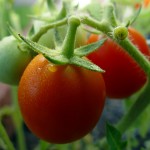In the Garden with Cindy
June is my birthday month and one of my favorite times of the year. There is so much life in the garden filled with color, texture, odor and taste that is difficult for this writer to choose a single topic. Because of this dilemma of unlimited subject potential and the limits of time and print space I’ve decided to do a column of answers to frequent questions I am often asked this time of year.
The first set of questions deals with the darling of the southern vegetable garden–tomatoes. The eating of the first tomato is an event–a zealously and jealously guarded secret feast usually reserved for the gardener himself or herself. Classic tomato sandwiches are made with Merita home style bread, spread liberally on both pieces of bread with Duke’s mayonnaise, salted and peppered with two thinly sliced pieces of ripe tomato. The sandwich  is gently smashed together and eaten quickly over the sink to catch the tomato drippings. Many questions must be answered before this climatic experience.
is gently smashed together and eaten quickly over the sink to catch the tomato drippings. Many questions must be answered before this climatic experience.
 is gently smashed together and eaten quickly over the sink to catch the tomato drippings. Many questions must be answered before this climatic experience.
is gently smashed together and eaten quickly over the sink to catch the tomato drippings. Many questions must be answered before this climatic experience.First, how do I plant a tomato? I plant tomatoes in both containers and in garden soil amended with compost and lime and with an application of Blossom-end rot preventative (sold in hardware stores in a bright yellow and red bag). If the transplant is tall, plant it horizontally, with all but the top 6 inches of leaves stripped down to the root and the top of the plant exposed to the air with the leaves. The reason for this is that roots will form along the horizontal length of the stem. Immediately, hammer a stake behind the plant, avoiding the long stem beneath the soil. As the tomato grows, take a nice soft hemp twine and tie the tomato loosely to the stake making a figure-eight knot at each six inches of stem. For my container gardens, I use good potting soil with a sparring amount of Blossom-end rot preventative and place the pots on my deck or at the base of the deck posts and use the posts to stake the tomatoes.
Next question: What in Hades is that fat green worm eating my tomato plants and why is it covered with ugly white larvae? That is a hornworm eating the tomato foliage and they will also eat peppers and eggplants. The yucky larvae are from a wasp that lays its eggs in the caterpillar and when the eggs hatch the caterpillar feast on the yummy green stuff inside the caterpillar as larvae. Pick these caterpillars off as soon as you notice them, I’m really grossed-out by the larvae so I use tweezers with long handles.
The next question is also dealing with garden pests: What has sucked the life from my squash plants, making their leaves wilt, and is there a cure? Oh no, this could be the evil vine borers! These are wrinkled, fat, white caterpillars with dark heads, about one inch long. Vine borers tunnel their way into squash plant stems and remain there, feeding as they move along. Signs of infestation include small entry holes near the base of the vine, greenish sawdust-like bug poop on the ground, and sudden wilting of the vine. It’s necessary to find the creature and destroy it by using a knife to slit the vine at the base and approach the wilted leaf in strokes. Don’t compost the affected stem and leaf–there could be more borers. A common deterrent is to sprinkle black pepper on the soil near the base of the plant, repelling the egg-laying moths.
The next question: How do I dead-head my petunias without removing buds of future blooms? This is a common question because the spent blossoms and petunia buds look very much alike. However, the spent blossoms are floppy like a popped balloon, while the buds are tight and turgid. Also the spent blossoms have a hard ball at the base that will eventually become seeds and stop the continued flowering of the plant, so pinch off the spent blossom below the ball of seeds.
I could go on for hours answering questions but as I explained, there are space limitations. If you have a question concerning gardening, please contact the Master Gardener line at the Extension service in Dallas (704-922-2124 or 704-922-0301). Have a wonderful June and get out there and plant, tend, and harvest your vegetables, herbs, and flowers!
